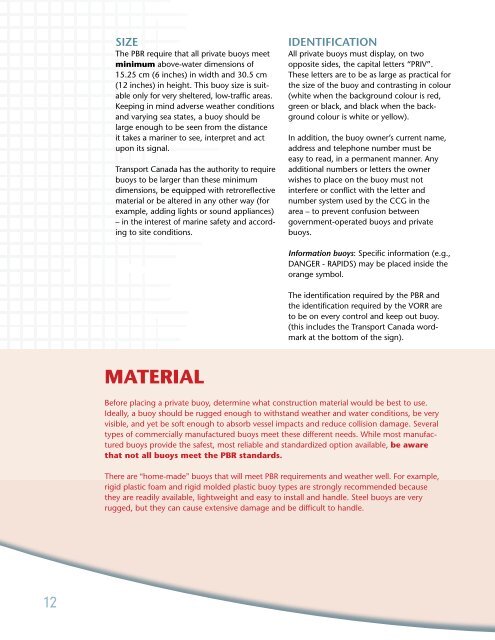A Guide to Private Buoys - Transports Canada
A Guide to Private Buoys - Transports Canada
A Guide to Private Buoys - Transports Canada
You also want an ePaper? Increase the reach of your titles
YUMPU automatically turns print PDFs into web optimized ePapers that Google loves.
SIZE<br />
The PBR require that all private buoys meet<br />
minimum above-water dimensions of<br />
15.25 cm (6 inches) in width and 30.5 cm<br />
(12 inches) in height. This buoy size is suitable<br />
only for very sheltered, low-traffic areas.<br />
Keeping in mind adverse weather conditions<br />
and varying sea states, a buoy should be<br />
large enough <strong>to</strong> be seen from the distance<br />
it takes a mariner <strong>to</strong> see, interpret and act<br />
upon its signal.<br />
Transport <strong>Canada</strong> has the authority <strong>to</strong> require<br />
buoys <strong>to</strong> be larger than these minimum<br />
dimensions, be equipped with retroreflective<br />
material or be altered in any other way (for<br />
example, adding lights or sound appliances)<br />
– in the interest of marine safety and according<br />
<strong>to</strong> site conditions.<br />
IDENTIFICATION<br />
All private buoys must display, on two<br />
opposite sides, the capital letters “PRIV”.<br />
These letters are <strong>to</strong> be as large as practical for<br />
the size of the buoy and contrasting in colour<br />
(white when the background colour is red,<br />
green or black, and black when the background<br />
colour is white or yellow).<br />
In addition, the buoy owner’s current name,<br />
address and telephone number must be<br />
easy <strong>to</strong> read, in a permanent manner. Any<br />
additional numbers or letters the owner<br />
wishes <strong>to</strong> place on the buoy must not<br />
interfere or conflict with the letter and<br />
number system used by the CCG in the<br />
area – <strong>to</strong> prevent confusion between<br />
government-operated buoys and private<br />
buoys.<br />
Information buoys: Specific information (e.g.,<br />
DANGER - RAPIDS) may be placed inside the<br />
orange symbol.<br />
The identification required by the PBR and<br />
the identification required by the VORR are<br />
<strong>to</strong> be on every control and keep out buoy.<br />
(this includes the Transport <strong>Canada</strong> wordmark<br />
at the bot<strong>to</strong>m of the sign).<br />
MATERIAL<br />
Before placing a private buoy, determine what construction material would be best <strong>to</strong> use.<br />
Ideally, a buoy should be rugged enough <strong>to</strong> withstand weather and water conditions, be very<br />
visible, and yet be soft enough <strong>to</strong> absorb vessel impacts and reduce collision damage. Several<br />
types of commercially manufactured buoys meet these different needs. While most manufactured<br />
buoys provide the safest, most reliable and standardized option available, be aware<br />
that not all buoys meet the PBR standards.<br />
There are “home-made” buoys that will meet PBR requirements and weather well. For example,<br />
rigid plastic foam and rigid molded plastic buoy types are strongly recommended because<br />
they are readily available, lightweight and easy <strong>to</strong> install and handle. Steel buoys are very<br />
rugged, but they can cause extensive damage and be difficult <strong>to</strong> handle.<br />
12

















